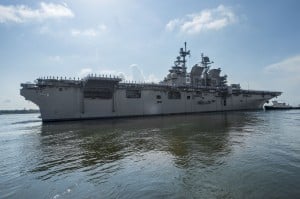
The future USS Ford is christened at Newport News shipyard.
This week, the Navy finally announced a delivery date for the long-delayed and $2.4 billion over-budget aircraft carrier, the Gerald Ford (CVN-78). “In hindsight,” said Adm. Thomas Moore, head of Naval Sea Systems Command, the Navy should have tested the Ford’s ambitious new systems more extensively on shore before installing them aboard ship. But building a new class of ship with “leap-ahead” technology is always risky, Moore told the Surface Navy Association: “We don’t build toasters. These are complex pieces of machinery.”
Given the problems the Ford has faced, we asked retired Navy commander Bryan Clark for an outside perspective on those problems and how to mitigate them. A career submariner, Clark has served at every level from enlisted man to head of the Chief of Naval Operations‘ Commander’s Action Group. He’s now with the Center for Strategic & Budgetary Assessments. Read On.. The Editors.

Bryan Clark
The Navy is paying the price for attempting to incorporate too many new technologies at once into a new class of ship. The Ford is an example of how short-lived strategic themes such as “transformation” can create long-term problems. The Ford carrier, Zumwalt destroyer, and F-35 Joint Strike Fighter were all shaped in large part by services’ need to get them approved by the Bush administration, which was only interested in pursuing transformational new technologies at the time.
This is not history we want to repeat. In our quest to pursue “Third Offset Strategy” technologies today, we will need to be judicious in how we incorporate them into new programs. The current Defense Department leadership has done a good job of refining these technologies in R&D programs until they mature, but sometimes these lessons eventually get forgotten.
As for the carrier program specifically, the Navy now is building parts of the next two carriers (the Kennedy, CVN-79, and Enterprise, CVN-80) and is buying some equipment for CVN-81 (as yet unnamed). Shipbuilder Huntington Ingalls has done some good work to get costs down, and has more to do. Many of the techniques they use for building nuclear-powered submarines, for example, can be applied to nuclear carriers, although it will require more investment and time due to the greater scale of carrier construction.
The Navy may be able to get costs for future carriers down further through multiyear procurement, essentially contracting for two carriers at a time and paying for them over multiple years. There are many pumps, valves, and other pieces of equipment on a carrier, and buying them in bulk for two ships can enable making them or buying them at a lower price. The Navy should start thinking about whether CVN-82, which hasn’t been started yet, should incorporate all the features of the first three Ford-class carriers. Some systems may be downscaled or removed to lower costs. (The Navy has already decided to install a more modest radar on CVN-79). Other options some have raised, such as shifting to a smaller carrier, would add more expense to develop and test the new designs.

LHA-6, the USS America
It will be about three years before Ford conducts a deployment, since after delivery it will enter the Fleet Response Plan training and preparation cycle. To address the continued shortfall in carriers and begin developing a more effective Amphibious Readiness Group, the Navy and Marine Corps should start deploying USS America (LHA-6) and other big-deck amphibious assault ships (LHAs and LHDs) as F-35B carriers. (This is something CSBA recommended in our fleet architecture and amphibious warfare studies; F-35Bs are “jump jets” capable of operating off the shorter flight decks of amphibs, rather than requiring a full-sized carrier). This would make the ARG able to provide fire support to Marines over the long ranges at which their MV-22 Osprey tilt-rotors can operate. It could also provide fighter support to support some of the small-scale operations, such as those in Syria, that are currently being supported part-time by aircraft carriers. The Navy has repeatedly tested such amphib-based air operations over Libya with its existing AV-8 Harrier jump jets, and the F-35B would be far more capable.
Sullivan: Defense industry ‘still underestimating’ global need for munitions
National Security Advisor Jake Sullivan said that there are “no plans” for another Ukraine supplemental at this point.


























